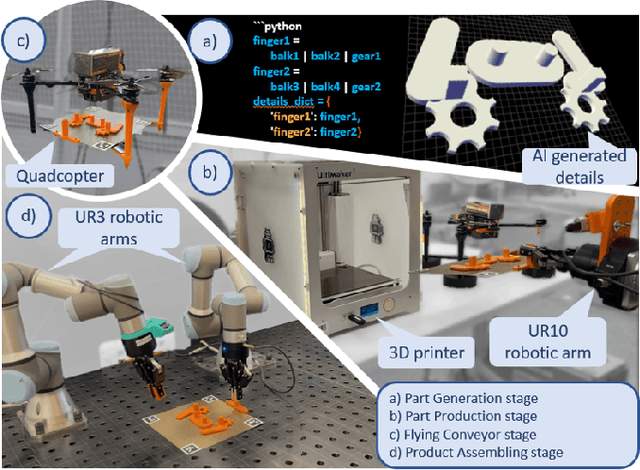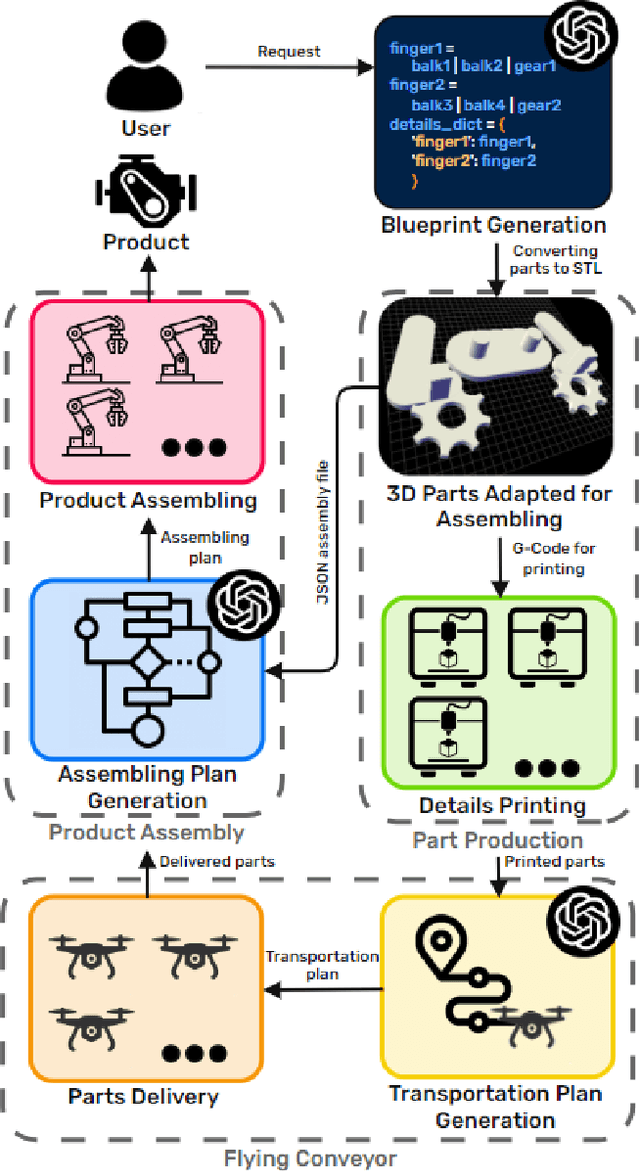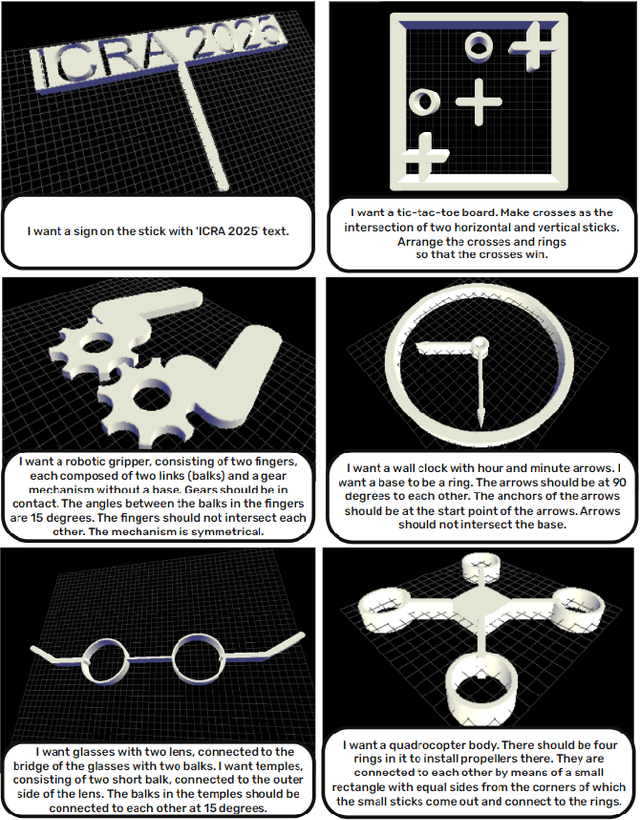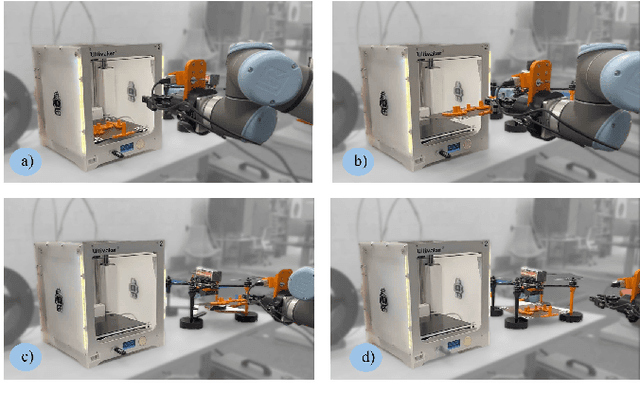Valerii Serpiva
FlightDiffusion: Revolutionising Autonomous Drone Training with Diffusion Models Generating FPV Video
Sep 19, 2025Abstract:We present FlightDiffusion, a diffusion-model-based framework for training autonomous drones from first-person view (FPV) video. Our model generates realistic video sequences from a single frame, enriched with corresponding action spaces to enable reasoning-driven navigation in dynamic environments. Beyond direct policy learning, FlightDiffusion leverages its generative capabilities to synthesize diverse FPV trajectories and state-action pairs, facilitating the creation of large-scale training datasets without the high cost of real-world data collection. Our evaluation demonstrates that the generated trajectories are physically plausible and executable, with a mean position error of 0.25 m (RMSE 0.28 m) and a mean orientation error of 0.19 rad (RMSE 0.24 rad). This approach enables improved policy learning and dataset scalability, leading to superior performance in downstream navigation tasks. Results in simulated environments highlight enhanced robustness, smoother trajectory planning, and adaptability to unseen conditions. An ANOVA revealed no statistically significant difference between performance in simulation and reality (F(1, 16) = 0.394, p = 0.541), with success rates of M = 0.628 (SD = 0.162) and M = 0.617 (SD = 0.177), respectively, indicating strong sim-to-real transfer. The generated datasets provide a valuable resource for future UAV research. This work introduces diffusion-based reasoning as a promising paradigm for unifying navigation, action generation, and data synthesis in aerial robotics.
PhysicalAgent: Towards General Cognitive Robotics with Foundation World Models
Sep 17, 2025Abstract:We introduce PhysicalAgent, an agentic framework for robotic manipulation that integrates iterative reasoning, diffusion-based video generation, and closed-loop execution. Given a textual instruction, our method generates short video demonstrations of candidate trajectories, executes them on the robot, and iteratively re-plans in response to failures. This approach enables robust recovery from execution errors. We evaluate PhysicalAgent across multiple perceptual modalities (egocentric, third-person, and simulated) and robotic embodiments (bimanual UR3, Unitree G1 humanoid, simulated GR1), comparing against state-of-the-art task-specific baselines. Experiments demonstrate that our method consistently outperforms prior approaches, achieving up to 83% success on human-familiar tasks. Physical trials reveal that first-attempt success is limited (20-30%), yet iterative correction increases overall success to 80% across platforms. These results highlight the potential of video-based generative reasoning for general-purpose robotic manipulation and underscore the importance of iterative execution for recovering from initial failures. Our framework paves the way for scalable, adaptable, and robust robot control.
AttentionSwarm: Reinforcement Learning with Attention Control Barier Function for Crazyflie Drones in Dynamic Environments
Mar 10, 2025Abstract:We introduce AttentionSwarm, a novel benchmark designed to evaluate safe and efficient swarm control across three challenging environments: a landing environment with obstacles, a competitive drone game setting, and a dynamic drone racing scenario. Central to our approach is the Attention Model Based Control Barrier Function (CBF) framework, which integrates attention mechanisms with safety-critical control theory to enable real-time collision avoidance and trajectory optimization. This framework dynamically prioritizes critical obstacles and agents in the swarms vicinity using attention weights, while CBFs formally guarantee safety by enforcing collision-free constraints. The safe attention net algorithm was developed and evaluated using a swarm of Crazyflie 2.1 micro quadrotors, which were tested indoors with the Vicon motion capture system to ensure precise localization and control. Experimental results show that our system achieves landing accuracy of 3.02 cm with a mean time of 23 s and collision-free landings in a dynamic landing environment, 100% and collision-free navigation in a drone game environment, and 95% and collision-free navigation for a dynamic multiagent drone racing environment, underscoring its effectiveness and robustness in real-world scenarios. This work offers a promising foundation for applications in dynamic environments where safety and fastness are paramount.
RaceVLA: VLA-based Racing Drone Navigation with Human-like Behaviour
Mar 04, 2025Abstract:RaceVLA presents an innovative approach for autonomous racing drone navigation by leveraging Visual-Language-Action (VLA) to emulate human-like behavior. This research explores the integration of advanced algorithms that enable drones to adapt their navigation strategies based on real-time environmental feedback, mimicking the decision-making processes of human pilots. The model, fine-tuned on a collected racing drone dataset, demonstrates strong generalization despite the complexity of drone racing environments. RaceVLA outperforms OpenVLA in motion (75.0 vs 60.0) and semantic generalization (45.5 vs 36.3), benefiting from the dynamic camera and simplified motion tasks. However, visual (79.6 vs 87.0) and physical (50.0 vs 76.7) generalization were slightly reduced due to the challenges of maneuvering in dynamic environments with varying object sizes. RaceVLA also outperforms RT-2 across all axes - visual (79.6 vs 52.0), motion (75.0 vs 55.0), physical (50.0 vs 26.7), and semantic (45.5 vs 38.8), demonstrating its robustness for real-time adjustments in complex environments. Experiments revealed an average velocity of 1.04 m/s, with a maximum speed of 2.02 m/s, and consistent maneuverability, demonstrating RaceVLA's ability to handle high-speed scenarios effectively. These findings highlight the potential of RaceVLA for high-performance navigation in competitive racing contexts. The RaceVLA codebase, pretrained weights, and dataset are available at this http URL: https://racevla.github.io/
CognitiveDrone: A VLA Model and Evaluation Benchmark for Real-Time Cognitive Task Solving and Reasoning in UAVs
Mar 03, 2025Abstract:This paper introduces CognitiveDrone, a novel Vision-Language-Action (VLA) model tailored for complex Unmanned Aerial Vehicles (UAVs) tasks that demand advanced cognitive abilities. Trained on a dataset comprising over 8,000 simulated flight trajectories across three key categories-Human Recognition, Symbol Understanding, and Reasoning-the model generates real-time 4D action commands based on first-person visual inputs and textual instructions. To further enhance performance in intricate scenarios, we propose CognitiveDrone-R1, which integrates an additional Vision-Language Model (VLM) reasoning module to simplify task directives prior to high-frequency control. Experimental evaluations using our open-source benchmark, CognitiveDroneBench, reveal that while a racing-oriented model (RaceVLA) achieves an overall success rate of 31.3%, the base CognitiveDrone model reaches 59.6%, and CognitiveDrone-R1 attains a success rate of 77.2%. These results demonstrate improvements of up to 30% in critical cognitive tasks, underscoring the effectiveness of incorporating advanced reasoning capabilities into UAV control systems. Our contributions include the development of a state-of-the-art VLA model for UAV control and the introduction of the first dedicated benchmark for assessing cognitive tasks in drone operations. The complete repository is available at cognitivedrone.github.io
AgilePilot: DRL-Based Drone Agent for Real-Time Motion Planning in Dynamic Environments by Leveraging Object Detection
Feb 10, 2025Abstract:Autonomous drone navigation in dynamic environments remains a critical challenge, especially when dealing with unpredictable scenarios including fast-moving objects with rapidly changing goal positions. While traditional planners and classical optimisation methods have been extensively used to address this dynamic problem, they often face real-time, unpredictable changes that ultimately leads to sub-optimal performance in terms of adaptiveness and real-time decision making. In this work, we propose a novel motion planner, AgilePilot, based on Deep Reinforcement Learning (DRL) that is trained in dynamic conditions, coupled with real-time Computer Vision (CV) for object detections during flight. The training-to-deployment framework bridges the Sim2Real gap, leveraging sophisticated reward structures that promotes both safety and agility depending upon environment conditions. The system can rapidly adapt to changing environments, while achieving a maximum speed of 3.0 m/s in real-world scenarios. In comparison, our approach outperforms classical algorithms such as Artificial Potential Field (APF) based motion planner by 3 times, both in performance and tracking accuracy of dynamic targets by using velocity predictions while exhibiting 90% success rate in 75 conducted experiments. This work highlights the effectiveness of DRL in tackling real-time dynamic navigation challenges, offering intelligent safety and agility.
SafeSwarm: Decentralized Safe RL for the Swarm of Drones Landing in Dense Crowds
Jan 13, 2025Abstract:This paper introduces a safe swarm of drones capable of performing landings in crowded environments robustly by relying on Reinforcement Learning techniques combined with Safe Learning. The developed system allows us to teach the swarm of drones with different dynamics to land on moving landing pads in an environment while avoiding collisions with obstacles and between agents. The safe barrier net algorithm was developed and evaluated using a swarm of Crazyflie 2.1 micro quadrotors, which were tested indoors with the Vicon motion capture system to ensure precise localization and control. Experimental results show that our system achieves landing accuracy of 2.25 cm with a mean time of 17 s and collision-free landings, underscoring its effectiveness and robustness in real-world scenarios. This work offers a promising foundation for applications in environments where safety and precision are paramount.
Industry 6.0: New Generation of Industry driven by Generative AI and Swarm of Heterogeneous Robots
Sep 16, 2024



Abstract:This paper presents the concept of Industry 6.0, introducing the world's first fully automated production system that autonomously handles the entire product design and manufacturing process based on user-provided natural language descriptions. By leveraging generative AI, the system automates critical aspects of production, including product blueprint design, component manufacturing, logistics, and assembly. A heterogeneous swarm of robots, each equipped with individual AI through integration with Large Language Models (LLMs), orchestrates the production process. The robotic system includes manipulator arms, delivery drones, and 3D printers capable of generating assembly blueprints. The system was evaluated using commercial and open-source LLMs, functioning through APIs and local deployment. A user study demonstrated that the system reduces the average production time to 119.10 minutes, significantly outperforming a team of expert human developers, who averaged 528.64 minutes (an improvement factor of 4.4). Furthermore, in the product blueprinting stage, the system surpassed human CAD operators by an unprecedented factor of 47, completing the task in 0.5 minutes compared to 23.5 minutes. This breakthrough represents a major leap towards fully autonomous manufacturing.
OmniRace: 6D Hand Pose Estimation for Intuitive Guidance of Racing Drone
Jul 16, 2024



Abstract:This paper presents the OmniRace approach to controlling a racing drone with 6-degree of freedom (DoF) hand pose estimation and gesture recognition. To our knowledge, it is the first-ever technology that allows for low-level control of high-speed drones using gestures. OmniRace employs a gesture interface based on computer vision and a deep neural network to estimate a 6-DoF hand pose. The advanced machine learning algorithm robustly interprets human gestures, allowing users to control drone motion intuitively. Real-time control of a racing drone demonstrates the effectiveness of the system, validating its potential to revolutionize drone racing and other applications. Experimental results conducted in the Gazebo simulation environment revealed that OmniRace allows the users to complite the UAV race track significantly (by 25.1%) faster and to decrease the length of the test drone path (from 102.9 to 83.7 m). Users preferred the gesture interface for attractiveness (1.57 UEQ score), hedonic quality (1.56 UEQ score), and lower perceived temporal demand (32.0 score in NASA-TLX), while noting the high efficiency (0.75 UEQ score) and low physical demand (19.0 score in NASA-TLX) of the baseline remote controller. The deep neural network attains an average accuracy of 99.75% when applied to both normalized datasets and raw datasets. OmniRace can potentially change the way humans interact with and navigate racing drones in dynamic and complex environments. The source code is available at https://github.com/SerValera/OmniRace.git.
GazeRace: Revolutionizing Remote Piloting with Eye-Gaze Control
Jul 12, 2024Abstract:This paper introduces the GazeRace method for drone navigation, employing a computer vision interface facilitated by eye-tracking technology. This interface is designed to be compatible with a single camera and uses a convolutional neural network to convert eye movements into control commands for the drone. Experimental validation demonstrates that users equipped with the eye-tracking interface achieve comparable performance to a traditional remote control interface when completing a drone racing task. Ten participants completed flight tests in which they navigated a drone through a racing track in a Gazebo simulation environment. Users reduced drone trajectory length by 18% (73.44 m vs. 89.29 m) using the eye-tracking interface to navigate racing gates effectively. The time taken to complete the route using the eye-tracking method (average of 70.01 seconds) was only 3.5% slower than using the remote control method (also average of 70.01 seconds), indicating the good efficiency of the interface. It is also worth mentioning that four of the participants completed the race with an average time that was 25.9% faster than the other participants. In addition, users evaluated highly the performance (M = 34.0, SD = 14.2) and low frustration (M = 30.5, SD = 9.2) with the eye-tracking interface compared to performance (M = 63.0, SD = 10.1) and frustration (M = 49.0, SD = 11.7) with the baseline remote controller. The hedonic quality (M = 1.65, SD = 0.45) was also evaluated high by the users in the UEQ questionnaire.
 Add to Chrome
Add to Chrome Add to Firefox
Add to Firefox Add to Edge
Add to Edge